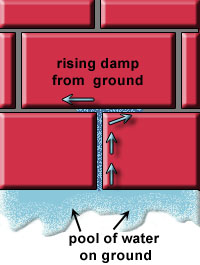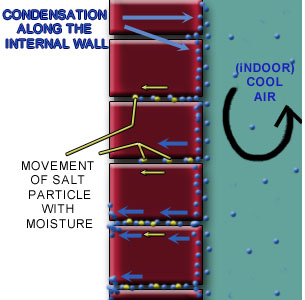Case 5
- Introduction
- Causes of Defects
- Good Practices
- Standards
- Maintenance and Diagnostics
- Remedial
- Similar Cases
- References
Cause of Defects
- Under certain conditions, tan or brown, and sometimes grey staining may occur on the mortar joints of brickwork. Occasionally, the brown stain will streak down onto the faces of the brick.
- During the brick firing process, the manganese coloring agents undergo several chemical changes, resulting in manganese compounds that are insoluble in water.
- They have varying degrees of solubility in weak acids. As previously discussed, acid solutions can occur in the brick in a wall. Also, the brick can absorb hydrochloric acid during the masonry cleaning process.
- It is also possible that in some areas rain water may be acidic.
- The manganese sulphate or chloride solutions from the brick will migrate across the mortar joints especially during a period of drying.
- These acidic manganese solutions will be neutralized by the inherent basic nature of the mortar.
- Upon neutralization, insoluble manganese hydroxide is precipitated on the mortar joints, and this is converted to brown Mn3O4on drying.
- Leaching of coloured compounds in mortar giving brown stains may also derive from iron impurities.
Possible sources of water:
a) Rainwater

The primary source of moisture for the occurrence of efflorescence is rain water which penetrates or comes in contact with masonry. Water film adheres to the external surfaces of wall and migrates via capillarity through the brickwork (Figure 1).
The presence of this free water in mortar joints could lead to the dissolution of alkaline salts available.Upon drying lime from the mortar is brought to the surface.
b) Rising dampness

From the picture, the lime bloom occurs not far from the ground DPC level. Another possible contributing factor of moisture is ground water carried up a wall (Figure 2).
c) Condensation
In addition to rainwater and groundwater, water may accumulate within the wall as a result of condensation of water vapor.

Condensation is usually due to moisture originating inside buildings. Cold air from internal air con unit may condense on the interior surface.This gain in moisture content increases the vapor pressure of the inside air substantially above that existing outdoors. This increased pressure tends to drive the vapor outwardly from the building interior through any vapor-porous materials that may comprise the enclosing surfaces.
When vapor passes through porous and homogeneous materials, mortar in this case, which may be warm on one side and cold on the other, encourages condensation. This condensed moisture can contribute to lime leaching on the mortar joints.